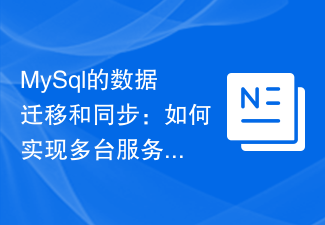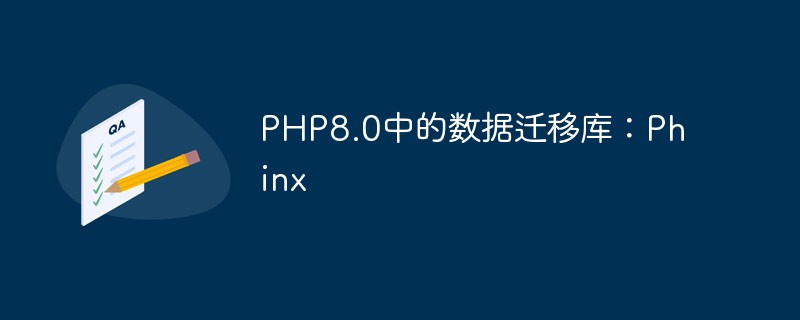 Backend Development
Backend Development Python Tutorial
Python Tutorial How to perform data reliability storage and migration in Python, as well as data consistency guarantee and verification
How to perform data reliability storage and migration in Python, as well as data consistency guarantee and verification
How to perform data reliability storage and migration in Python, as well as data consistency guarantee and verification
Introduction: Data security and consistency are important for any Applications are critical. In Python, we can use some technologies and libraries to ensure the reliable storage and migration of data, as well as the guarantee and verification of data consistency. This article will introduce several commonly used methods and provide code examples.
1. Reliable Data Storage
Reliable storage of data refers to safely storing data in persistent storage media to prevent data loss or damage. Below are some commonly used methods and techniques in Python.
- Use a database management system (DBMS): Python has many DBMS to choose from, such as MySQL, SQLite, PostgreSQL, etc. Data can be easily created, read, updated and deleted using these DBMS. Below is a simple example that demonstrates how to use SQLite to create a data table and insert some data.
import sqlite3
# 连接到数据库文件
conn = sqlite3.connect('example.db')
# 创建一个数据表
conn.execute('''CREATE TABLE IF NOT EXISTS users
(id INT PRIMARY KEY NOT NULL,
name TEXT NOT NULL);''')
# 插入数据
conn.execute("INSERT INTO users (id, name) VALUES (1, 'John')")
conn.execute("INSERT INTO users (id, name) VALUES (2, 'Jane')")
# 提交更改并关闭连接
conn.commit()
conn.close()- Using file system: In addition to using DBMS, we can also save data in the file system. Python provides many modules to handle file operations, such as
picklemodule for object serialization and deserialization,csvmodule for processing CSV files,jsonModules are used to process JSON data and more. Below is an example of using thepicklemodule to save an object to a file.
import pickle
# 定义一个对象
class Person:
def __init__(self, name, age):
self.name = name
self.age = age
# 保存对象到文件
person = Person('John', 25)
with open('person.pickle', 'wb') as f:
pickle.dump(person, f) 2. Data reliability migration
Data reliability migration refers to moving data from one system or storage medium to another to ensure the integrity and security of the data sex. Below are some commonly used methods and techniques in Python.
- Use the import and export functions of DBMS: If you are using a DBMS to store data, you can usually migrate the data using the import and export functions provided by the DBMS itself. Taking MySQL as an example, you can use the
mysqldumpcommand to export data, and then use themysqlcommand to import data. - Use third-party tools and libraries: In addition to the functions provided by DBMS, there are also some third-party tools and libraries that can help us with data migration. For example, the
pandaslibrary can be used to import and export data. ,sqlalchemylibrary can be used for data migration between different DBMS, etc. Below is an example of using thepandaslibrary to import data from a CSV file into a SQLite database.
import pandas as pd
from sqlalchemy import create_engine
# 从CSV文件中读取数据
data = pd.read_csv('data.csv')
# 将数据导入到SQLite数据库
engine = create_engine('sqlite:///example.db')
data.to_sql('data', engine, if_exists='replace')3. Guarantee and verification of data consistency
Data consistency refers to maintaining the accuracy and consistency of data in multiple data sources. The following are some commonly used methods and techniques in Python.
- Use transaction (Transaction): Transaction is a mechanism to ensure that data operations succeed or fail at the same time in an atomic operation. When using a DBMS to operate a database, transactions can be used to ensure the consistency of multiple database operations. Below is an example of using the
sqlite3module to implement a simple transaction.
import sqlite3
# 连接到数据库文件
conn = sqlite3.connect('example.db')
# 开始一个事务
conn.isolation_level = 'EXCLUSIVE'
conn.execute('BEGIN EXCLUSIVE')
# 执行一系列数据库操作
conn.execute("UPDATE users SET name = 'Jane Smith' WHERE id = 1")
conn.execute("UPDATE users SET name = 'John Doe' WHERE id = 2")
# 提交事务
conn.commit()
# 关闭连接
conn.close()- Use checksum (Checksum): Checksum is a mechanism used to detect data integrity. In Python, we can use the
hashliblibrary to calculate the checksum of data. Below is an example of calculating a string checksum.
import hashlib
# 计算字符串的MD5校验和
data = 'Hello, world!'
md5 = hashlib.md5()
md5.update(data.encode('utf-8'))
checksum = md5.hexdigest()
print(checksum)Summary:
In Python, we can use a variety of methods and technologies to ensure the reliable storage and migration of data, as well as the guarantee and verification of data consistency. This article describes some common methods and provides code examples. When data needs to be processed, appropriate methods and tools are selected based on the specific situation to ensure data security and consistency.
The above is the detailed content of How to perform data reliability storage and migration in Python, as well as data consistency guarantee and verification. For more information, please follow other related articles on the PHP Chinese website!
 轻松搞定!华为手机新旧机数据迁移指南Mar 23, 2024 pm 01:54 PM
轻松搞定!华为手机新旧机数据迁移指南Mar 23, 2024 pm 01:54 PM在当今社会,手机已经成为人们生活中不可或缺的一部分,而随着科技的迅速发展,手机的更新换代也变得越来越频繁。当我们购买了一部新的华为手机时,最让人头疼的问题之一就是如何将旧手机中的重要数据顺利迁移到新手机上。而华为作为国内一家领先的通讯设备制造商,自带的数据迁移工具正好可以解决这个难题。本文将为大家详细介绍如何利用华为手机官方提供的数据迁移工具,轻松搞定新旧机
 MySql的数据迁移和同步:如何实现多台服务器之间的MySQL数据迁移和同步Jun 15, 2023 pm 07:48 PM
MySql的数据迁移和同步:如何实现多台服务器之间的MySQL数据迁移和同步Jun 15, 2023 pm 07:48 PMMySQL是一个非常流行的开源关系型数据库管理系统,广泛应用于各种Web应用、企业系统等。在现代业务的应用场景下,大多数的MySQL数据库需要部署在多台服务器上,以提供更高的可用性和性能,这就需要进行MySQL数据的迁移和同步。本文将介绍如何实现多台服务器之间的MySQL数据迁移和同步。一.MySQL数据迁移MySQL数据迁移指的是将MySQL服务器中的数
 使用Laravel进行数据迁移和填充:灵活管理数据库结构Aug 26, 2023 am 09:28 AM
使用Laravel进行数据迁移和填充:灵活管理数据库结构Aug 26, 2023 am 09:28 AM使用Laravel进行数据迁移和填充:灵活管理数据库结构概要:Laravel是一个非常流行的PHP框架,它提供了便捷的方式来管理数据库结构,包括数据迁移和数据填充。在本文中,我们将介绍如何使用Laravel的迁移和填充功能来灵活地管理数据库结构。一、数据迁移数据迁移是用于管理数据库结构变更的工具。它允许您使用PHP代码来定义和修改数据库表、列、索引和约束等元
 使用Java编写的微服务数据同步与数据迁移工具Aug 09, 2023 pm 05:15 PM
使用Java编写的微服务数据同步与数据迁移工具Aug 09, 2023 pm 05:15 PM使用Java编写的微服务数据同步与数据迁移工具在当今互联网时代,微服务架构已经成为广泛应用的一种设计模式。在微服务架构中,服务之间的数据同步和迁移成为了一项关键任务。为了解决这一问题,我们可以使用Java编写一个简单而强大的微服务数据同步与数据迁移工具。在这篇文章中,我将详细介绍如何使用Java编写这个工具,并提供一些代码示例。准备工作首先,我们需要准备一些
 PHP8.0中的数据迁移库:PhinxMay 14, 2023 am 10:40 AM
PHP8.0中的数据迁移库:PhinxMay 14, 2023 am 10:40 AM随着互联网技术的发展和应用范围的不断扩大,数据迁移变得越来越常见和重要。数据迁移是指将现有的数据库结构和数据移到不同环境或新的系统上的过程。数据迁移的过程中,可以包括从一个数据库引擎到另一个数据库引擎、从一个数据库版本到另一个数据库版本、不同的数据库实例、或者从一个服务器到另一个服务器。在PHP开发领域,Phinx是一个广泛使用的数据迁移库。Phinx支持数
 如何从 PC 切换到 Mac 并将数据从 Windows 迁移到 macOSMay 10, 2023 pm 04:28 PM
如何从 PC 切换到 Mac 并将数据从 Windows 迁移到 macOSMay 10, 2023 pm 04:28 PM对于不熟悉Apple操作系统macOS的人来说,从Windows转移到Mac可能是一个很棒但令人生畏的想法。以下是潜在的PC到Mac切换器在跳跃平台时应考虑的一切。人们可以出于许多不同的原因切换平台,从对现有环境的挫败感到需要搬家上班或单纯的好奇心。在某些情况下,切换可能会被强加给毫无戒心的用户,例如如果家庭成员给了他们一台Mac。无论从Windows迁移到Mac的原因是什么,这样做的决定只是第一步。接下来,您必须将计算环境从Windows迁移到新的和不熟悉的环境。这似乎
 华为手机如何快速导入旧手机数据?Mar 23, 2024 pm 10:30 PM
华为手机如何快速导入旧手机数据?Mar 23, 2024 pm 10:30 PM华为手机如何快速导入旧手机数据?在当今信息化的社会中,手机已经成为人们生活中不可或缺的一部分。随着科技的发展和人们对手机功能的需求不断增加,更换手机已经成为一种常见的现象。而当我们升级到一部全新的华为手机时,如何快速并且有效地将旧手机上的数据迁移到新手机上成为了一项需要解决的问题。对于许多使用旧手机的用户来说,手机里存储了大量的联系人、短信、照片、音乐、视频
 MySQL和Oracle:对于多版本并发控制和数据一致性的支持对比Jul 12, 2023 pm 01:10 PM
MySQL和Oracle:对于多版本并发控制和数据一致性的支持对比Jul 12, 2023 pm 01:10 PMMySQL和Oracle:对于多版本并发控制和数据一致性的支持对比引言:在当今数据密集型应用中,数据库系统扮演着核心角色,实现数据的存储和管理。MySQL和Oracle是两个著名的关系型数据库管理系统(RDBMS),在企业级应用中广泛使用。在多用户环境下,保证数据一致性和并发控制是数据库系统的重要功能。本文将分享MySQL和Oracle在多版本并发控制和数据


Hot AI Tools

Undresser.AI Undress
AI-powered app for creating realistic nude photos

AI Clothes Remover
Online AI tool for removing clothes from photos.

Undress AI Tool
Undress images for free

Clothoff.io
AI clothes remover

AI Hentai Generator
Generate AI Hentai for free.

Hot Article

Hot Tools

SublimeText3 English version
Recommended: Win version, supports code prompts!

SAP NetWeaver Server Adapter for Eclipse
Integrate Eclipse with SAP NetWeaver application server.

WebStorm Mac version
Useful JavaScript development tools

SublimeText3 Linux new version
SublimeText3 Linux latest version

MinGW - Minimalist GNU for Windows
This project is in the process of being migrated to osdn.net/projects/mingw, you can continue to follow us there. MinGW: A native Windows port of the GNU Compiler Collection (GCC), freely distributable import libraries and header files for building native Windows applications; includes extensions to the MSVC runtime to support C99 functionality. All MinGW software can run on 64-bit Windows platforms.





